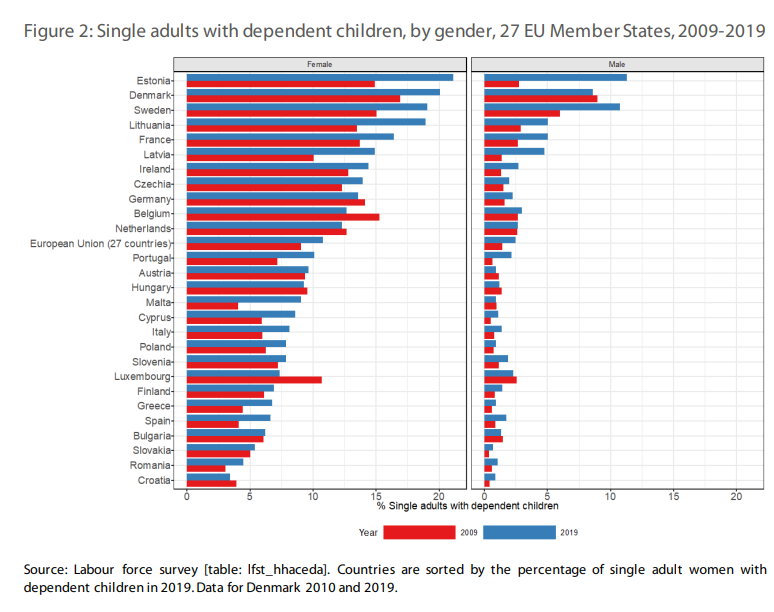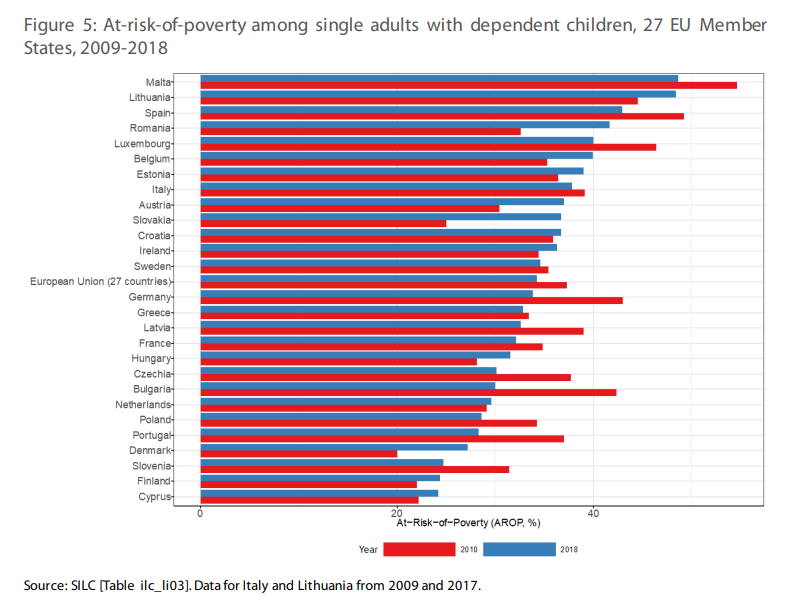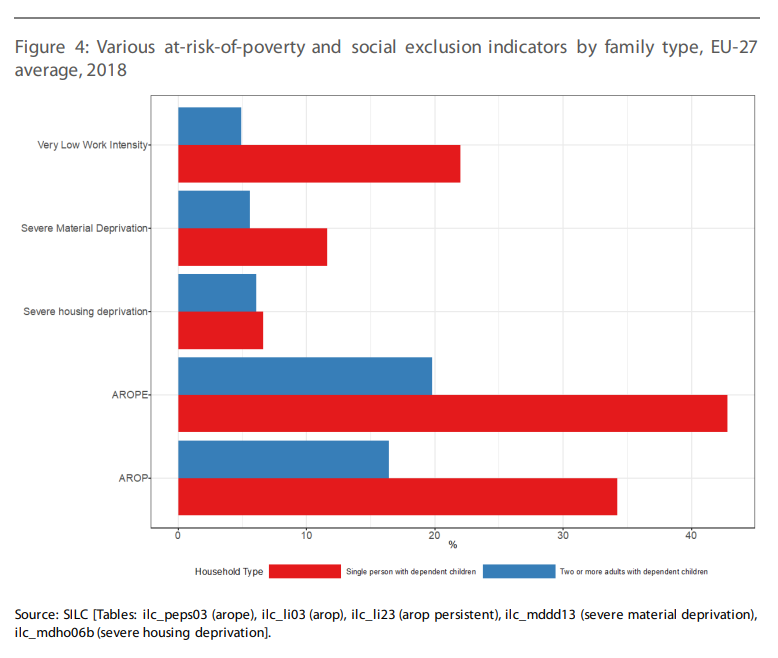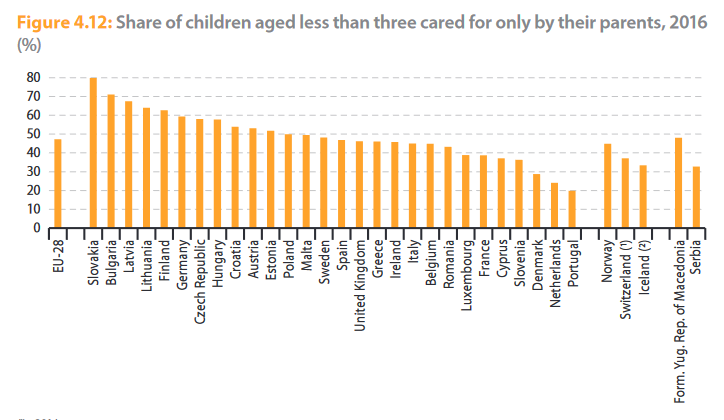Single-parent families in the Home & Care project – A local and European perspective
- an above average number in single-parent families are women
- an above average number of these women with their children are affected by poverty
- and again that, among the single-parent women affected by poverty, an above-average number have a migration background.
In the framework of the project, the scientific monitoring team of the project led by Prof. Liel from the University of Applied Sciences Landshut has presented a scientific poverty and social structure analysis of local findings related to the developments in Germany and the situation in neighboring European countries. The focus of this analysis was put on the living conditions and poverty risk of single-parent families.
In all EU countries, a large proportion of single-parent families are still headed by women, despite a current trend in the opposite direction. In many EU countries, mothers are more than twice as likely to assume the primary parental role in single-parent families rather than fathers.

(Nieuwenhuis 2020:13)
On average across all 27 Member States, over 1/3 of single parents are at risk of poverty.

(Nieuwenhuis 2020:17)
In many countries, the above-average poverty risk of single-parent families becomes particularly clear when compared with the poverty risk of two-parent families: in Denmark, Ireland, Germany, Luxembourg and Italy, there is a difference of 20%. Accordingly, single-parent families face a significantly higher risk of poverty compared to two-parent families. In an international comparison, Germany has a low poverty risk for two-parent families (4%), but in contrast a very high poverty risk for single-parent families (32%) (Härkönen 2018:41).
On average in Europe, single-parent families show an increased risk of poverty compared to two-parent families in all the poverty indicators presented (see figure 4).

(Nieuwenhuis 2020:14-16)
The reasons for the particularly high burden of poverty of single-parent families are multidimensional. In addition to the systemic disadvantages inherent to the double burden of single parents as the main person responsible for ensuring family income and care for the children, there are other reasons in which individual challenges have a very detrimental effect. These include disadvantages such as comparatively low educational attainment or gender discrimination.
For example, it can be seen that single parents are more likely to have a low level of education and that the risk of poverty increases as the level of education decreases (Härkönen 2018:39). Especially in Germany, it can be seen that single mothers are more likely to work part-time (40.0%) than full-time (27.9%) (Jaehrling et al. 2014:353, as of 2008). Furthermore, it is striking that in the countries studied, Germany, France and Sweden, women in two-parent families tend to work more frequently than women in single-parent families, regardless of the extent of employment (Jaehrling et al. 2014:353; status 2003-2008). Moreover, for the countries studied, Finland and Germany, it can be seen that the employment of single mothers also increases as the age of their youngest child increases (Zagel and Hübgen 2018:177-78).
In addition, single mothers face a particular burden due to existing gender-specific disadvantages. For example, the classic understanding of roles is still deeply rooted in our society. It is true that there is a process of change in the sense of emancipation and the redefinition of the understanding of roles. Nevertheless, more than 60% of the population surveyed in western Germany in 2008 agreed with the statement, "A young child is likely to suffer if the mother works" (Jaehrling et al. 2011: 31).
That parental care continues to be highly valued can also be assumed by the proportion of under-threes who are cared for exclusively by parents. 
(Eurostat 2018:105)
With a view to structural disadvantages in the world of work, it can be noted that the classic understanding of roles continues to have an impact on the framework conditions that influence employment for women. One example is the gender pay gap, which means that men are often given preferential treatment when it comes to salaries because of differences in age, education level and career choice (Kümmerling and Postels 2020: 196).
The additional responsibility of childcare for single mothers often leads them to enter unstable employment in favor of flexible work schedules. For example, the employment situation (2008) of mothers in Germany, France, and Sweden shows that single mothers are twice as likely as mothers in two-parent families to engage in temporary employment, are more likely to start a new employment relationship, and are more likely to enter a period of unemployment (Jaehrling et al. 2014:355-56).
Furthermore, single mothers show a less adequate work-life balance than two parents (Horemans and Marx 2018:197).
Overall, it is clear that many factors such as.
- gender culture,
- working conditions that inhibit work-life balance,
- an unstable employment relationship but also
- individual characteristics such as low educational attainment
influence women's gainful employment.
For single mothers, the overall responsibility as a single person and bearing the financial situation of the family alone is contrary to the responsibility towards the care of the children (Morissens 2018: 359).
In order to improve the precarious financial situation of single-parent families and to counteract a high risk of poverty, benefits are needed in family policy that can also have an impact on women's employment. In this context, current political efforts primarily see the shift in parental care toward the use of public care services as a basis for combating poverty (Effinger and Saxonberg 2015:97).
In Europe, in particular the Scandinavian countries can be highlighted positively, as some of them recognized and promoted the need for public childcare for under-threes as early as the 1960s. In the meantime, these countries have been able to develop childcare for both over-three-year-olds and under-three-year-olds that largely covers demand and is offered all day for the most part (Seils and Molitor 2021:3).
Germany, on the other hand, has long focused primarily on expanding state childcare for children aged three and older. It was not until the early 2000s that the childcare shortage for children under three was addressed. As a first step, the Day Care Expansion Act (Tagesbetreuungsausbaugesetz, TAG) focused on more formal care for young children and promoted its expansion, as well as regulating the qualification of childminders. However, the expansion of all-day care differs greatly between eastern and western Germany. In the West, the rate of all-day child care has increased from 19.9% (as of 2008) to 38.6% (as of 2017), but in the East, all-day care is much more common, with a share of 73.6% (as of 2017) (Seils and Molitor 2021:20f.).
Single-parent families are a vulnerable group both in Germany and across Europe, characterized by a particularly high poverty risk rate. The comparatively low employment rate of single-parent families is considered the main indicator of poverty. Above all, sole responsibility for childcare leads to precarious working conditions that do not offer sufficient protection against poverty. Due to the high proportion of single-parent families headed by mothers, an understanding of roles that creates different working conditions for women than for men must also be addressed in connection with the high poverty risk rate.
Against this background, the Home & Care project deliberately refers to factors that can be identified throughout Europe when considering the poverty risk of single-parent families. The focus is on women who tend to have low educational qualifications, for whom the project is creating a training program tailored to the needs of single parents, for example through more flexible time frames. In addition, the project is creating improved working conditions that contribute to a better work-life balance and address the insufficient supply of formal care for (young) children, thus targeting the low labor force participation rate. An example of this is the flexible offer of care in off-peak hours, e.g. with the help of the door-to-door concept. In addition, the financial situation of single-parent families has been improved with the creation of housing with affordable rents. Home & Care has thus provided an answer to the various disadvantages and is gathering knowledge on how these answers can also be used in other municipalities.
Many thanks for the support and the kind provision of the data to Ms. Andrea Döllner from the University of Applied Sciences Landshut!
About this resource
The Urban Innovative Actions (UIA) is a European Union initiative that provided funding to urban areas across Europe to test new and unproven solutions to urban challenges. The initiative had a total ERDF budget of €372 million for 2014-2020.
Similar content




